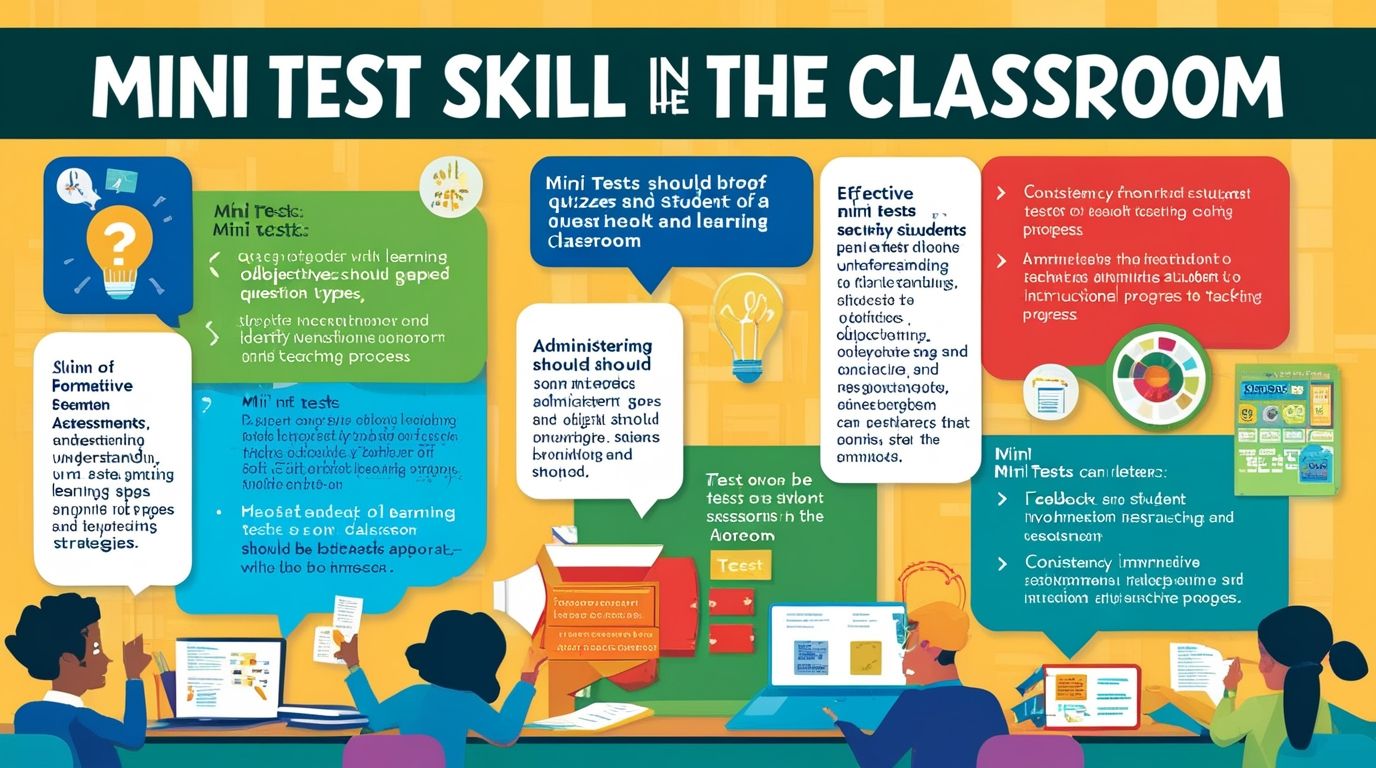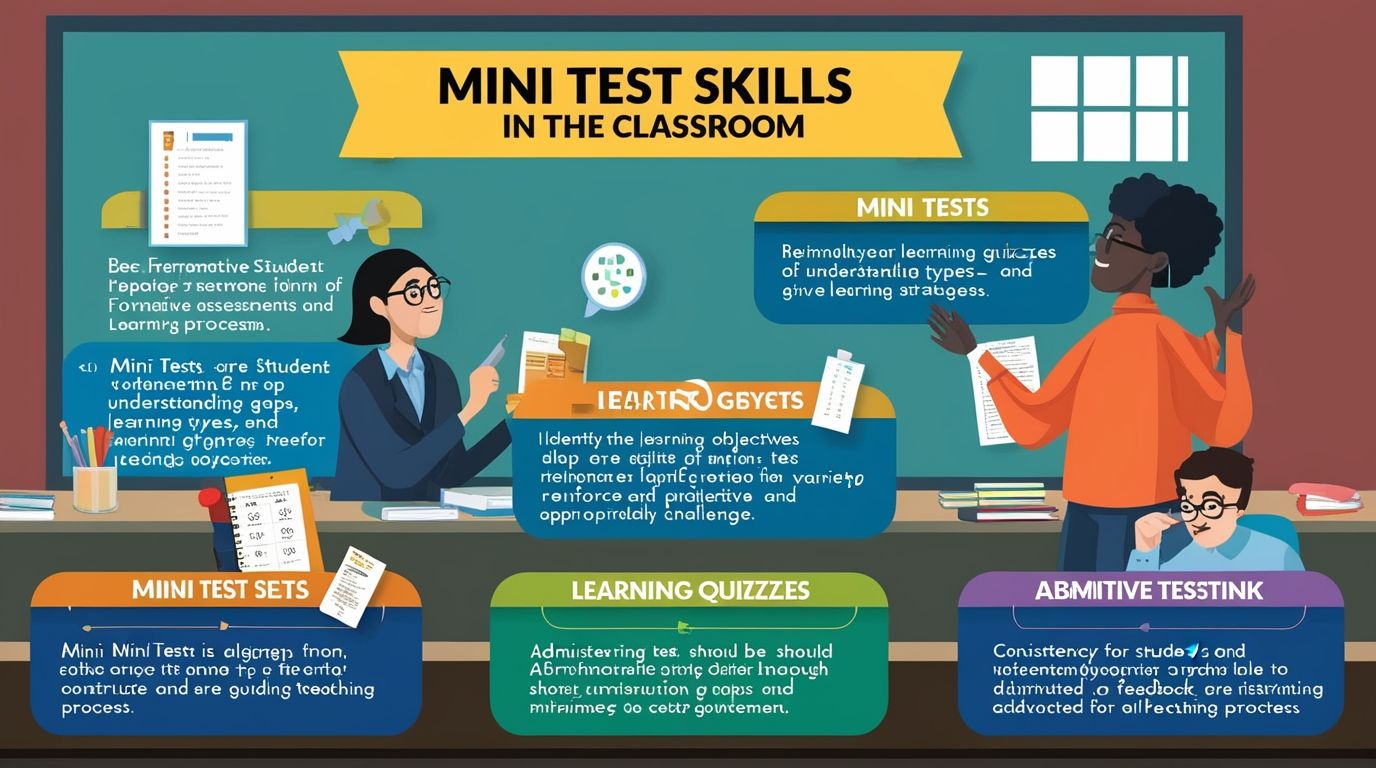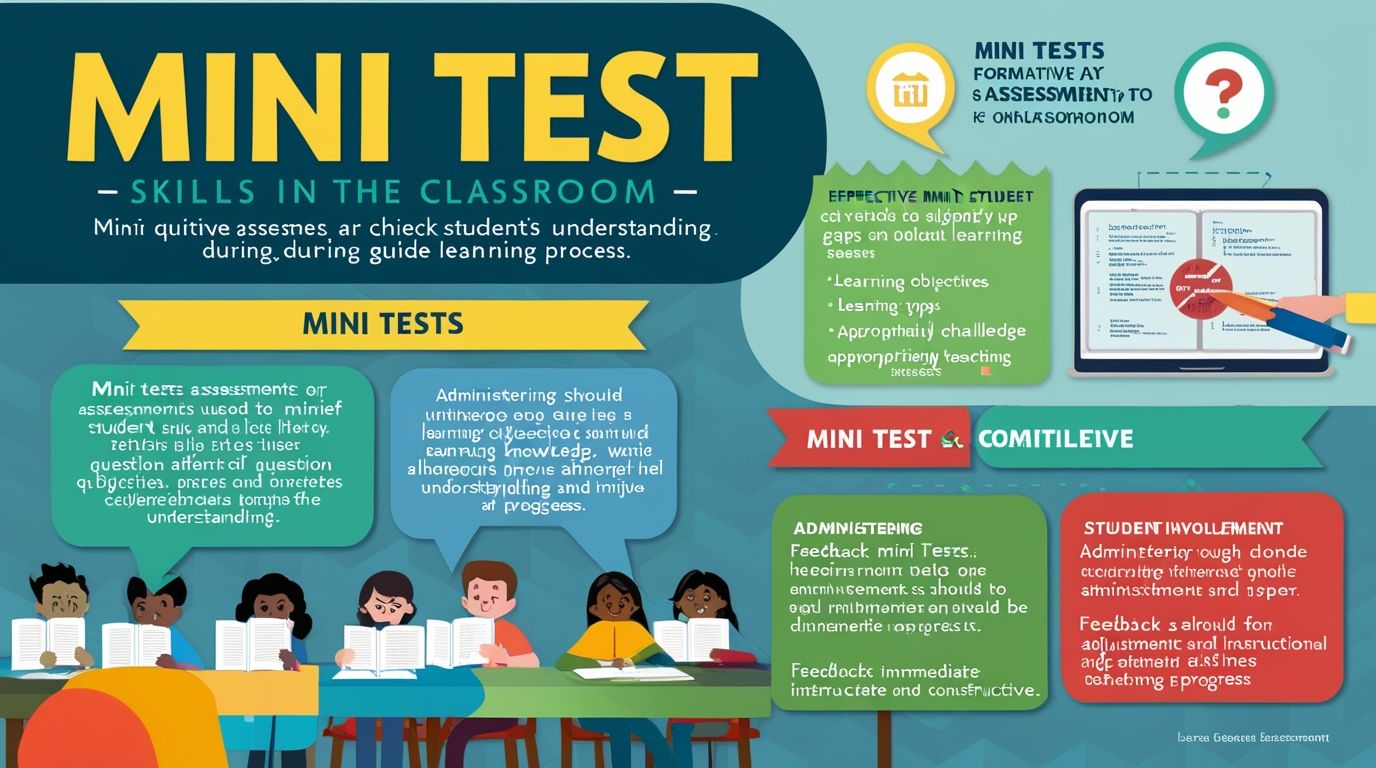Introduction
Mini Test Skills in the Classroom, Mini tests, often referred to as formative assessments or quizzes, are short, targeted assessments used in the classroom to gauge student understanding of specific concepts. Unlike summative assessments that evaluate cumulative knowledge at the end of a unit, mini tests are used regularly throughout a learning period to provide immediate feedback to both students and teachers. These assessments can be a powerful tool for enhancing learning, fostering student engagement, and guiding instructional strategies.
Importance of Mini Test Skills
The use of mini tests in the classroom offers several benefits. Firstly, they help in identifying gaps in students’ understanding in real-time, allowing educators to adjust their teaching strategies accordingly. Secondly, mini tests encourage students to regularly review content, which can improve retention and mastery of the material. Lastly, mini tests provide students with a low-stakes opportunity to practice test-taking skills, reducing anxiety and improving performance on high-stakes assessments.
Developing mini test skills involves crafting effective questions, administering tests efficiently, and using results constructively. Teachers need to understand how to design questions that accurately reflect learning objectives, interpret results to inform teaching, and provide feedback that motivates students.

Designing Effective Mini Tests
1. Alignment with Learning Objectives
Effective mini tests are directly aligned with the learning objectives of the lesson. This ensures that the test measures what students are expected to learn. For example, if a lesson’s objective is to understand the causes of the American Revolution, the mini test should focus on questions that assess this knowledge rather than unrelated historical facts. By aligning questions with specific learning outcomes, educators can more accurately assess whether students have achieved the desired level of understanding.
2. Question Variety and Clarity
Incorporating a variety of question types—such as multiple-choice, short answer, and true/false—can cater to different learning styles and provide a more comprehensive assessment of student knowledge. The clarity of questions is also critical; ambiguous wording can lead to confusion and misinterpretation, which undermines the effectiveness of the assessment. Questions should be straightforward, directly related to the content, and designed to assess specific skills or knowledge.
3. Appropriate Difficulty Level
The difficulty level of mini test questions should match the students’ current level of understanding. Questions that are too easy do not challenge students, while overly difficult questions can be discouraging. A balanced approach involves including questions of varying difficulty levels to cater to all students and provide a more accurate measure of class-wide understanding.
4. Time Management
Mini tests should be short, typically taking no more than 10-15 minutes of class time. This brevity ensures that they serve as a quick check-in rather than a major disruption to the lesson. Effective time management also involves considering how often mini tests are administered; weekly or bi-weekly tests are generally sufficient to monitor progress without overwhelming students.
Administering Mini Tests
1. Digital Tools and Platforms
With the rise of technology in education, many teachers are using digital platforms like Google Forms, Kahoot, and Quizlet to administer mini tests. These tools can automate the grading process, provide instant feedback, and allow for easy data tracking. Digital tests also cater to diverse learning needs by incorporating multimedia elements like images, audio, and video.
2. Paper-Based vs. Digital Assessments
While digital tools offer convenience, some educators prefer traditional paper-based tests for their simplicity and accessibility in classrooms with limited technology resources. Paper-based assessments are often easier to implement in younger classrooms or in settings where screen time is a concern.
3. Encouraging Honest Effort
To ensure that mini tests accurately reflect student understanding, it’s important to foster an environment where students feel encouraged to put forth honest effort. This can be achieved by emphasizing the purpose of mini tests as a learning tool rather than a judgment of ability. Minimizing the stakes by not heavily weighting these tests in overall grading also helps reduce anxiety and promotes a growth mindset.
Utilizing Mini Test Results
1. Immediate Feedback
One of the greatest benefits of mini tests is the ability to provide immediate feedback. When students receive prompt feedback, they can quickly correct misconceptions and reinforce learning while the material is still fresh. Feedback should be specific, constructive, and focused on guiding students toward the correct answer rather than simply highlighting what was wrong.
2. Informing Instructional Adjustments
Teachers can use the results of mini tests to inform instructional adjustments. For example, if a significant number of students struggle with a particular concept, the teacher might decide to review that topic in more depth, use different instructional strategies, or provide additional resources. This dynamic approach helps create a responsive learning environment where teaching is continually tailored to meet student needs.
3. Tracking Progress Over Time
Mini tests also allow teachers to track student progress over time, offering a clear picture of individual and class-wide growth. By analyzing trends in mini test results, educators can identify which areas are consistently challenging for students and which instructional methods are most effective. This data-driven approach supports continuous improvement in teaching and learning.
Challenges in Implementing Mini Tests
1. Time Constraints
While mini tests are intended to be brief, finding time to regularly administer and review them can be challenging, especially in already packed curricula. Teachers must balance the frequency of mini tests with other instructional demands to avoid overwhelming students and themselves.
2. Student Resistance
Students may initially resist frequent testing, viewing it as a burdensome or stressful activity. To mitigate this, educators should clearly communicate the purpose of mini tests as tools for learning and growth rather than as punitive measures. Engaging students in discussions about their results and involving them in setting learning goals can also help increase buy-in.
3. Ensuring Fairness and Accessibility
Ensuring that mini tests are fair and accessible to all students is another challenge. This includes considering students with disabilities, language barriers, or varying levels of test anxiety. Teachers should strive to create inclusive assessments that accommodate diverse needs, such as by providing extra time, alternate formats, or supportive resources.

Best Practices for Maximizing the Benefits of Mini Tests
1. Consistency and Routine
Incorporating mini tests as a regular part of classroom routine helps normalize the practice and reduces anxiety associated with assessments. Consistent administration—such as every Friday or at the end of each topic—creates a predictable environment where students know what to expect.
2. Student Involvement in the Process
Engaging students in the process of creating mini tests can also enhance their effectiveness. For example, teachers might allow students to suggest potential questions, which not only increases engagement but also encourages deeper reflection on the material. Additionally, self-assessment or peer review exercises can further develop students’ test-taking skills and self-regulation.
3. Reflective Practices
Encouraging students to reflect on their mini test performance is another best practice. This can be facilitated through reflective prompts, discussions, or journaling activities where students consider what they did well, what they struggled with, and how they can improve. Such reflective practices foster a growth mindset and promote lifelong learning skills.
Conclusion
Mini test skills are a valuable component of effective teaching, providing ongoing insights into student learning and offering opportunities for immediate feedback and instructional adjustments. When implemented thoughtfully, mini tests can significantly enhance the educational experience, making learning more dynamic, responsive, and student-centered. By focusing on clear alignment with learning objectives, varied question types, efficient administration, and constructive use of results, educators can maximize the benefits of mini tests and better support their students’ academic growth.
References
- Black, P., & Wiliam, D. (2009). Developing the theory of formative assessment. Educational Assessment, Evaluation and Accountability, 21(1), 5-31.
- Brookhart, S. M. (2010). How to give effective feedback to your students. ASCD.
- Popham, W. J. (2011). Transformative assessment in action: An inside look at applying the process. ASCD.

4 thoughts on “Mini Test Skills in the Classroom”
Comments are closed.